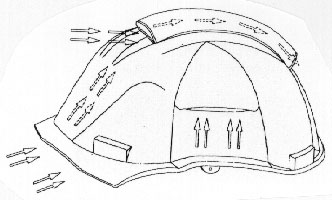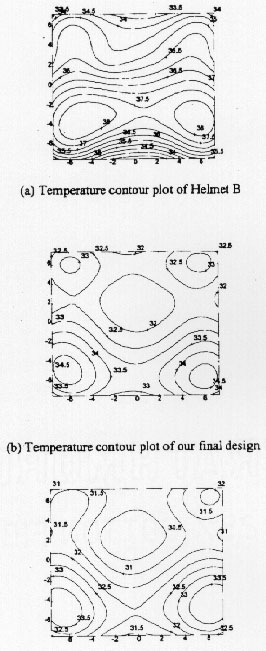
ABSTRACT
The manufacturing technology has been changed rapidly during the last thirty years due to the impact of computer revolution. In order to meet the challenge from these computer-based technology and strengthen students' ability in using computer to solve the manufacturing problem, an integrated computer-aided curriculum for mechanical design is proposed. This integrated computer-aided curriculum is based on a two years basis for a junior student. The curriculum includes a one-year mechanical design course follow by a course focus on mechanical design project. 12 subjects are taught in the mechanical design course which link to the geometric modeling, optimization, finite element analysis, mechanical components and design process. Through these short subjects, the students may discover the existing technology for mechanical design and then build up their competence on unsolved problems. A one-year mechanical design project are then prepared after the mechanical design course. The product-oriented project covers the technology of design, analysis and manufacturing and thus enhances the students' abilities as a engineer.
INTRODUCTION
The idea that engineers need to create a new design to solve every problem is quickly becoming obsolete. With computer technology advancing at a dizzying pace, the first step in the modern design process is to browse the Internet or other information system to see if someone else has already designed a transmission, a brake, or a heat exchanger that is close to what you need. The availability of computers and access to the information highway dramatically enhance the capabilities of the engineering team and its productivity. The most noticeable change in product development is the drastically shorter time allotted to create a successful product. Development cycles for major products have been compressed from six years, which used to be typical for both automobiles and mainframe computers, to less than two years. For other products, the development cycle may be as shorter as six months. Being late to market, therefore, means writing off a substantial portion of the anticipated profits, which will place subsequent product development efforts at a financial disadvantage.
To tackle the changes from the computer revolution, the bachelor's degree of Mechanical Engineering should have a product development orientation. Students should be exposed to the classical design theory as well as to emerging fields. As a result, the need for engineering graduates who can evaluate, master, and deploy new tools and reconfigure engineering processes to maximize such tools' potential benefit is more pressing than ever. A graduate who can identify an opportunity to implement a new technology and then find, learn, and implement the necessary tools effectively may be valued more than a graduate who is expert in the use of a particular tool. However, the ability to learn new tools as the need arises is just one of the assets engineering students need to acquire in the course of an education that prepares them for a lifetime learning. After all, computing tools aren't used in vacuum: They are means to an end, such as solving an engineering problem or developing a product.
An integrated computer-aided curriculum for mechanical design is developed in the Department of Mechanical Engineering at Yuan-Ze Institute of Technology. The curriculum includes a one-year mechanical design course for the junior students and a one- year project course for the senior students. The contents and ideas of this curriculum are briefly described in this paper.
The goal of the design course strives to achieve is simple and clear: to provide students the tools and environment to experience design, despite our limited resources. In order to be able to experience design, the students must be given enough "design tools." As in a typical design course, there are two major activities in our course model: lectures and student projects. The purpose of the lectures is not to teach the students profound theories, but to help the students build their own "design tool box" -- to let them know what tools are available to them for doing design.
A variety of subjects are taught in this one-year course, and each subject is taught for only about two weeks. With the purpose of building a design tool box, the lectures really emphasize breadth rather than depth, applications rather than deep theories. It is expected that after the lectures, students have basic understanding of the subject, and are able to study further the subject on their own when they need to use the design tool, or to take an advanced course on the subject if they find themselves interested in it.
Currently 12 subjects are arranged in our course model These subjects were selected because we think they are the fundamental tools the students must have in order to be able to do mechanical design.
(1) Design Process (I) -- Specification Development.
(2) Structural Analysis.
(3) Computer Aided Design (I) -- Finite Element Analysis.
(4) Mechanical Components (I) -- Transmission.
(5) Design Process (II) -- Conceptual Design and Evaluation.
(6) Computer Aided Design (II) -- Design Optimization.
(7) Sensors and Electronic Components.
(8) Design Drawings and Documentation.
(9) Mechanical Components (II) -- Bearings, Bolts, Clutch, and Brakes.
(10) Hydraulics and Pneumatics.
(11)Mechanical Vibrations.
(12) Computer Aided Design (III) -- Geometric Modeling.
This is a rather drastic change in content from the more "traditional" mechanical design courses in the universities in Taiwan. There can be no standard textbook. Substantial handouts are prepared. The subjects and the content of the subjects are reviewed and updated each summer to reflect the latest changes in technologies and local industries.
Many engineering graduates agree that gaining hands-on experience in conceiving and executing a project in a team environment is the most valuable training a future engineer can have. The project can help students to put tools and teamwork in perspective within the product-realization process. Consequently, they need good communication and research skills to gain an understanding of a future employer's corporate strategy and competitive environment. The students also must be able to devise strategies for implementing a variety of tools and work processes to achieve these goals. Above all, they need to acquire the personal skills to work with others as part of a team. Two projects are proposed in the course of mechanical design project and illustrated in the following.
Industrial safety helmets provide protection for the top of the head against small falling objects striking the top of the shell in industrial environments. Most of the tests in the standards that apply to industrial safety helmets are to measure whether a helmet can provide effective protection to the wearers. Considerable amount of research has also been done on the performance in impact and shock absorbing ability of the safety helmet.
However, many workers are not willing to put on helmets simply because it is not comfortable wearing helmets. The "comfort performance," which may often be overlooked, is obviously another important issue for industrial safety helmet design. Heckling discussed 12 factors that affect the acceptability of head protection at work: weather protection, thermal properties, tactile properties, absorbability permeability, mass distribution, degree of fit, size and shape, retention performance and fit, helmet volume, visual factors, speech and sound factors, and helmet compatibility. Among these 12 factors, the one of immediate concern by the workers in a subtropical climate such as that of Taiwan, is the thermal properties of industrial safety helmets.
The project presented in this paper focused on redesigning the shell of the industrial safety helmet to improve its thermal properties. In this project, first an experiment was established to simulate the conditions of a head wearing a helmet. Helmets of different types and makes were then tested. The average temperature beneath the helmet shell, the speed of heat dissipation through convection, and the temperature contour beneath the helmet shell, were used to describe the thermal properties of a helmet. Various design concepts, e.g., adding ventilation holes, increasing clearance between the helmet shell and the head, covering the shell with reflective materials, were also tested. Finally some design suggestions for improving the thermal properties of industrial safety helmet shells were made.
According to these design suggestions, a new design prototype was developed, tested, and further modified. At this stage, attentions were also paid to structural safety, appearance, manufacturability, and other practical issues. Finally we developed our final helmet shell design which is shown in figure 1. The thermal properties of this final design have significantly improved over other commercially available helmets we tested. The contour of the temperature distribution of the helmet is shown in figure 2. It also passed the weight, impact, and penetration tests of the Chinese National Standards (CNS).
Another course project in the year 1996 is a gas engine powered light weight fuel-efficient single passenger car design and fabrication, we also attended the national "super-mileage" competition hosted by the ROC chapter of Society of Automatic Engineering, SAE-ROC. Many aspects of product development are included throughout the project, starting from the definition of product specification, performance analysis and estimation, structure analysis, material selection, detail design, manufacture scheduling, road testing and many other experiments to complete this project. Software packages applied to this project include (1) ANSYS for the structure analysis, (2) numeric analysis package MATLAB for the overall optimal driving strategy design, (3) CNC CAD/CAM packages like AUTOCAD and SMARTCAM for the production of complicated parts including the mold for the fabrication of glass fiber made outer shell and (4) ADAMS for the automobile dynamic analysis. In the course of designing such complicated project, the students learned that the proper use of an analysis program involves not only specifying the correct loads and boundary conditions but also keep in mind the end user of the product at hand. They need to know how to manage the design trade-offs. Above all, they realized that " it's better to be done than to be perfect "
In the future, software packages like FLOW-3D for low air-drag body design is also in our plan as well as other optimal design packages for light weight structure design. In addition, CAD packages for control system design using microcomputers for engine control and speed control are another possible direction of development. Throughout this course, students are divided into several groups like power-train, steering, structure and testing, carrying out required analysis, research, design and fabrication work. Group reports are presented in regular meetings such that every team member can understand what other people did and learned the functions and applications of each software package.
The challenge for manufacturing engineering education is to develop an appropriate response to the rapid advances in technology and future needs. The students have to be prepared not just to adapt but to lead the way. The engineering schools should help future engineers adapt the engineering process to new tools as they emerge. The integrated curriculum provides several benefits:
The authors would like to gratefully acknowledge the generous support of the National Science Council of Taiwan under the project no. 84-2514-S-155-003.

Figure 1. Our final helmet shell design. The arrows indicate air flow. up

(c) Temperature contour plot of our final design, with reflective material covering the top portion of the shell.
Figure 2. Temperature contour plots. up